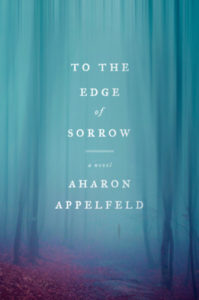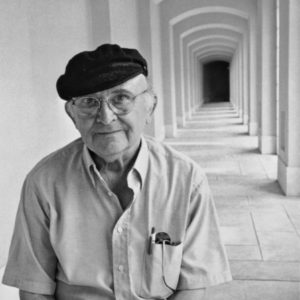 From the opening paragraph of Aharon Appelfeld’s novel, To the Edge of Sorrow, readers enter the realm of a small group of Jewish resistance fighters in a Ukrainian forest in the latter part of World War II. Through the eyes of a teenager named Edmund, I came to appreciate the resiliency and determination of these people. Despite deplorable conditions, they were unwilling to surrender to the German Army or local collaborators. The stronger personalities had an uncanny ability to protect the weaker ones. The will to live superseded bouts of depression and outright discouragement over their bleak and frightening situation.
From the opening paragraph of Aharon Appelfeld’s novel, To the Edge of Sorrow, readers enter the realm of a small group of Jewish resistance fighters in a Ukrainian forest in the latter part of World War II. Through the eyes of a teenager named Edmund, I came to appreciate the resiliency and determination of these people. Despite deplorable conditions, they were unwilling to surrender to the German Army or local collaborators. The stronger personalities had an uncanny ability to protect the weaker ones. The will to live superseded bouts of depression and outright discouragement over their bleak and frightening situation.
A week after finishing the book, I still hear Edmund’s voice and recall poignant details shedding light on vulnerable and strong characters. Being estranged from his parents, Edmund regrets how he treated his parents before their separation. Like many of the other characters, Edmund’s past secrets and disappointments are recalled throughout the book.
An orphaned preschooler, Milio, rescued outside the ghetto, remains speechless until the end of the story. This child’s predicament reminds me of the countless number of Jewish children who were traumatized by the Holocaust. Ninety-three-year-old Grandma Tsirl symbolizes Jewish traditions and the Jewish concept of L’dor V’dor (from generation to generation). Her strong spirit became the “essence of the tribe.” (page 49) Many sought her advice and blessings. Edmund benefitted from her words, “righteousness saves a person from an unnatural death. All the more so from sin.” (page 166)
Led by a man named Kamil, these Jews maintained their humanity even though each day was met with intense uncertainty. He instilled a sense of purpose. “it is to become aware of ourselves, of parents and grandparents and their faith. Hopefully we can shake free of fixed opinions and prejudices and open our eyes to see not only what we usually see but also what we are prevented from seeing.” (page 23)
Books taken from raided homes enriched their depleted lives and simultaneously stirred their emotions. Characters representing the religious community as well as secular groups such as the leftist bund, the communist party, and Shomer Hatza’ir (Socialist Zionism) outwardly debated the contents of these books, revealing the complexity of Jewish thought in the mid 20th century. Even the selected language for study—Yiddish or Hebrew— was questioned.
Like Big Karl, a Communist, some had previously walked away from traditional Judaism. “We left the ghetto not only to save ourselves but also to break away once and for all from an irrational tradition and to live as free men.” (Page 26) Big Karl unabashedly recounted the way Jewish Communists physically and verbally attacked all aspects of Jewish religious life.
On the other side of the spectrum, Isidore embraced the Hasidic prayers and melodies from his youth. Even though Isidore was raised in a secular home, he attended religious services with his grandfather. While faith was a rallying cry for Kamil and other traditionally orientated Jews, secular Jews strongly dismissed religious thought. Appelfeld adeptly weaved in several more characters who were part of squads performing missions. Some acted as fighters, others helped with daily operations, and a few cared for the sick and the wounded.
Despite their differences, the characters became united in their quest to defeat evil and to save lives. “There is beauty and elegance on the inside. The wicked must be vanquished, and the inner beauty must be zealously protected.” (Page 202) Raids on boxcars increased their numbers. These rescued Jews put additional demands on their resources. Although stretched to their limit, their humanity prevailed.
To the Edge of Sorrow encourages readers to reflect once again on the Shoah and how it affected mankind. While the emphasis is on the interactions of this small band of Jewish resistance fighters, encounters with local citizens, a German officer, a kidnapped village doctor, and a Ukrainian tracker offer momentary glimpses into prevailing attitudes towards Jews. Most distressing was the perspective of the kidnapped physician. “…for Krinitski taking care of Jews is humiliating, a deep insult to his dignity. He would rather die than be a prisoner of the Jews and care for their sick.” (page 218)
Although it has been several years since I agreed to do a book review, I was approached by Rose Cronin-Jackman to read the translation of To the Edge of Sorrow. Both the author and the description caught my attention, so I agreed to accept a complimentary proof copy.
Aharon Appelfeld

Appelfeld, an award-winning Israeli author, passed away in 2018. Most biographers draw attention to dozens of his Hebrew Language novels focusing on Eastern Europe and the Holocaust, most of which have been translated into other languages. Like many of his fictional characters, Appelfeld was a child survivor of the Holocaust. After the war, he moved to Israel before it became a state.
Taking time to read stories about the Holocaust is a necessity in a time when worldwide anti-Semitism is escalating. Works of fiction authored by aging Shoah survivors offer a portal into a world few can describe accurately. In memory of Appelfeld’s life and accomplishments, I’m sharing this review.
International Holocaust Remembrance Day
January 27—the anniversary of the liberation of Auschwitz-Birkenau—is International Holocaust Remembrance Day. If you cannot attend an event, consider reading To the Edge of Sorrow.
To learn more about Aharon Appelfeld (1932-2018) and his published works, check out this site.
Book Giveaway
Anyone who leaves a comment on this blog by February 29, 2020 will be eligible for a book giveaway. I will send the randomly selected North American winner copy of To The Edge of Sorrow. The book will only be mailed to a North American address.
Disclosure
Prior to posting this blog, I was sent a complimentary copy of To The Edge of Sorrow.
Bio
Sandra Bornstein is the author of May This Be the Best Year of Your Life. Sandra’s memoir highlights her living and teaching adventure in Bangalore, India. She was a licensed Colorado teacher who taught K-12 students in the United States and abroad as well as college-level courses. In addition to reviewing books and interviewing authors, Sandra is the content coordinator/writer for Golden Living and a freelance lifestyle and travel writer.
Leave a Reply
You must be logged in to post a comment.